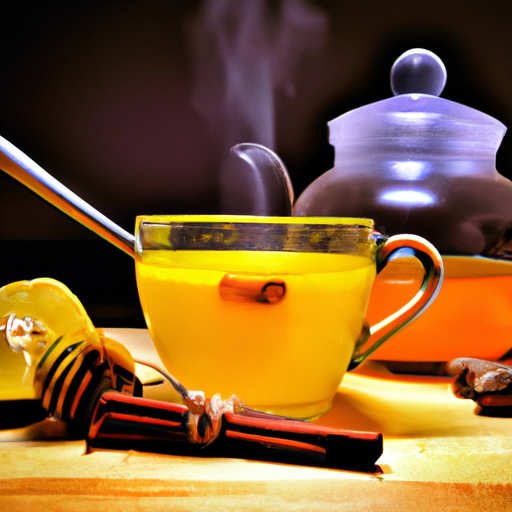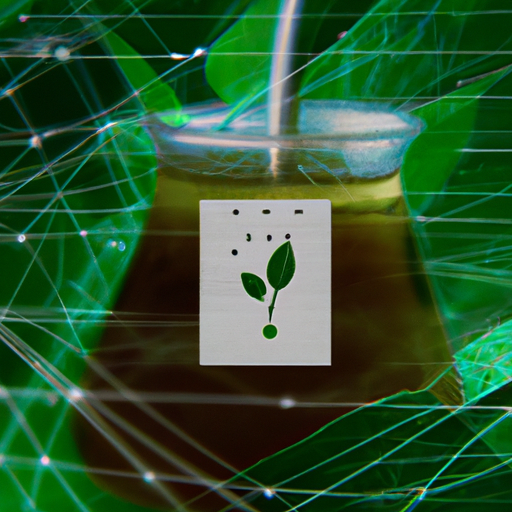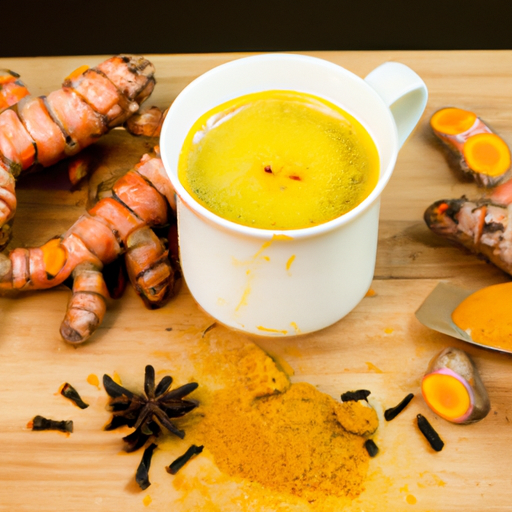For years, I’ve incorporated turmeric tea into my daily regimen, making it an essential part of my routine. It not only offers a distinct flavor but also delivers a variety of health advantages.
Turmeric is known for its anti-inflammatory properties, which can help reduce inflammation throughout the body. It also contains antioxidants that can protect against free radicals and promote healthy aging.
If you are new to turmeric tea or looking to switch up your recipe, this article will provide you with everything you need to know. From traditional recipes to vegan options and even an iced version, we’ve got you covered.
Plus, we’ll share tips on storing and reheating your turmeric tea so that you can enjoy it anytime. So let’s get started on how to prepare turmeric tea!
Key Takeaways
- Choosing organic and sustainably sourced turmeric is recommended for maximum health benefits.
- Non-dairy alternatives like almond milk, coconut milk, oat milk, or soy milk can enhance the flavor and provide unique health benefits.
- Adding natural sweeteners like honey or maple syrup and spices like cinnamon, ginger, and black pepper can enhance the taste and provide health benefits.
- Turmeric tea has numerous health benefits, including reducing inflammation, improving brain function, and boosting the immune system.
Gather Your Ingredients
When I prepare my turmeric tea, there are a few key ingredients that I make sure to have on hand. First and foremost, choosing the right type of turmeric is crucial for achieving the desired flavor and health benefits.
Additionally, whether you prefer dairy or non-dairy alternatives, selecting the right milk can greatly impact the taste and texture of your tea.
Finally, adding sweeteners such as honey or spices like ginger can enhance the overall experience of enjoying this delicious beverage.
Choosing the Right Turmeric
To get the most benefits out of your turmeric tea, you’ll want to choose a high-quality turmeric powder that’s fresh and bright in color. The quality of turmeric can vary greatly depending on where it’s sourced from, so it’s important to do your research and find a reputable brand that offers organic and sustainably sourced turmeric.
Here are a few things to keep in mind when choosing the right turmeric for your tea:
- Look for bright yellow-orange color: This indicates that the turmeric hasn’t been sitting on the shelf for too long and still contains its active compounds.
- Choose organic: Non-organic turmeric may contain harmful chemicals or pesticides, which can negate any potential health benefits.
- Check the source: Turmeric grown in India is generally considered to be of higher quality due to its favorable climate conditions.
By selecting high-quality turmeric, you can ensure that your tea will provide maximum health benefits. Now let’s move on to the next step, which involves deciding whether to use milk or non-dairy alternatives.
Milk or Non-Dairy Alternatives
You might think that adding milk to your turmeric tea is a no-brainer, but hold on – did you know that non-dairy alternatives can actually enhance the flavor and health benefits? While milk is a popular choice for many people, it’s important to consider other options such as almond milk, coconut milk, oat milk, or soy milk. These alternatives not only provide a different taste profile but also offer unique health benefits.
To help you choose which non-dairy alternative to use in your turmeric tea, here is a table comparing the nutritional content of each option:
| Milk Alternative | Calories | Fat (g) | Protein (g) | Calcium (%DV) |
|---|---|---|---|---|
| Almond Milk | 60 | 2.5 | 1 | 45 |
| Coconut Milk | 80 | 8 | <1 | 10 |
| Oat Milk | 120 | 5 | 3 | 35 |
| Soy Milk | 80 | 4 | 7 | 30 |
As you can see from the table above, each non-dairy alternative has its own unique nutritional profile. For example, soy milk provides more protein than any of the other options while coconut milk has higher fat content. Ultimately, the choice depends on personal preference and dietary needs. Regardless of which option you choose, incorporating a non-dairy alternative can add depth and richness to your turmeric tea while providing various health benefits.
Moving forward into our discussion about sweeteners and spices…
Sweeteners and Spices
Spice up your non-dairy alternative with a touch of sweetness to elevate the flavor and make your taste buds dance. While turmeric has its own unique flavor, adding natural sweeteners like honey or maple syrup can help balance out any bitterness. These natural sweeteners not only enhance the taste but also provide health benefits such as antioxidants and anti-inflammatory properties.
In addition to sweeteners, spices can also be added to turmeric tea for an extra kick of flavor. Cinnamon, ginger, and black pepper are great options that not only add deliciousness but also have their own health benefits. For instance, cinnamon is known for its ability to regulate blood sugar levels while ginger helps with digestion and reduces inflammation. Adding these spices to your turmeric tea can take it to the next level both in terms of taste and health benefits.
Now that we’ve talked about how to spice up your non-dairy alternative with natural sweeteners and spices, let’s move on to the traditional turmeric tea recipe without milk or non-dairy alternatives involved.
Traditional Turmeric Tea Recipe
If you’re feeling under the weather, this traditional turmeric tea recipe is like a warm hug in a cup. Not only does it have a comforting taste and aroma, but it also offers numerous health benefits. Turmeric has been used for centuries in Ayurvedic medicine to treat various ailments, and drinking turmeric tea is an easy way to incorporate its benefits into your daily routine.
Here are some of the health benefits of turmeric tea:
| COLUMN 1 | COLUMN 2 |
|---|---|
| Anti-inflammatory properties | Boosts immune system |
| Improves brain function | Reduces risk of heart disease |
| Helps with digestion | Promotes healthy skin |
To make the traditional turmeric tea recipe, start by boiling two cups of water in a small saucepan. Add one teaspoon of ground turmeric and let it simmer for about ten minutes. Strain the mixture through a fine mesh sieve or cheesecloth into a mug. Add honey or lemon juice to taste.
While this recipe is delicious on its own, there are many variations you can try to switch things up. In the next section, we’ll explore some different ways to prepare turmeric tea that will keep your taste buds interested while still reaping all the health benefits.
Variations on the Traditional Recipe
I’ve been experimenting with different ways to make turmeric tea and I’ve found some delicious variations on the traditional recipe.
One way to add a little extra flavor and health benefits is by including ginger, cinnamon, or cardamom in the mix.
Another option is to turn the tea into a latte by adding milk and honey.
And for those who don’t have fresh turmeric root on hand, using turmeric powder can be just as effective.
These simple tweaks can take your daily cup of turmeric tea to the next level!
Adding Ginger, Cinnamon, or Cardamom
To enhance the flavor and health benefits of your turmeric tea, try adding ginger, cinnamon, or cardamom – they’re all delicious and have their own unique properties that will complement the turmeric.
Not only do these spices add a tasty twist to your tea, but they also provide additional health benefits. Ginger is known for its anti-inflammatory properties while cinnamon helps regulate blood sugar levels. Cardamom is rich in antioxidants and can help with digestion.
When adding these spices to your turmeric tea, you can either use fresh or ground versions. For fresh ginger or cardamom pods, simply slice or crush them before brewing with the turmeric. If using ground versions of any of the three spices, mix them in with the turmeric powder before adding hot water.
Experiment with different combinations to find your favorite blend.
Now that you know how to spice up your turmeric tea, let’s move on to making a turmeric latte – another delicious way to enjoy this healthy beverage!
Making a Turmeric Latte
Get ready for a cozy and comforting drink with a turmeric latte – perfect for chilly evenings or lazy afternoons. This delicious beverage is not only a treat for your taste buds but also has numerous health benefits due to the presence of turmeric. Curcumin, the active ingredient in turmeric, has anti-inflammatory and antioxidant properties that can help reduce inflammation, improve brain function, lower the risk of heart disease, and even prevent cancer.
To make a turmeric latte at home, you will need some basic ingredients such as milk (dairy or non-dairy), turmeric powder, cinnamon powder, honey or maple syrup (optional), and black pepper. Here is a simple recipe you can follow:
| Ingredients | Measurements |
|---|---|
| Milk | 1 cup |
| Turmeric Powder | 1 tsp |
| Cinnamon Powder | 1/4 tsp |
| Honey or Maple Syrup (optional) | 1-2 tsp |
| Black Pepper Powder | A pinch |
Firstly, heat one cup of milk in a saucepan over medium heat until it comes to a simmer. Then add one teaspoon of turmeric powder and mix well. Add cinnamon powder and sweetener (if using) according to your preference and stir again. Finally, add a pinch of black pepper powder which helps improve the absorption of curcumin in the body. Once everything is mixed well together, pour into your favorite mug and enjoy!
If you want to use turmeric powder for other recipes as well, keep reading on how to use it effectively without any mess!
Using Turmeric Powder
You can easily add a dash of turmeric powder to your morning smoothie or oatmeal for an extra boost of antioxidants and anti-inflammatory benefits. Turmeric has been shown to have numerous health benefits, including reducing inflammation, improving brain function, and lowering the risk of chronic diseases like heart disease and cancer.
However, it’s important to note that the dosage recommendations for turmeric are not yet established, so it’s best to consult with a healthcare professional before adding large amounts of turmeric to your diet.
If you’re interested in trying out a delicious and healthy way to incorporate turmeric into your daily routine, consider making a vegan turmeric tea recipe. This warming beverage is made from simple ingredients like water, fresh ginger root, ground cinnamon, black pepper and honey (optional).
Not only does this tea offer all the wonderful health benefits of turmeric but it also provides a comforting way to start your day or wind down at night.
Vegan Turmeric Tea Recipe
This vegan turmeric tea recipe is a delicious and healthy way to start your day. Turmeric has been used for centuries as a natural remedy due to its anti-inflammatory properties. It also contains antioxidants that help protect your body from free radicals, which can damage cells and lead to disease.
Apart from using it in cooking, turmeric can also be used in alternative ways such as skincare and hair care. To make this vegan turmeric tea, you’ll need the following ingredients: 1 cup of water, 1 teaspoon of grated fresh ginger, ½ teaspoon of ground turmeric, 1 teaspoon of honey (or any sweetener of your choice), and a squeeze of lemon juice.
Start by bringing the water to boil in a small pot. Add the grated ginger and let it simmer for about 5 minutes. Then add the ground turmeric and stir well. Turn off the heat and let it sit for another 5 minutes before straining into your mug.
Finally, add honey or any other sweetener to taste along with a squeeze of lemon juice. If you prefer an iced version of this tea, simply prepare it as above but let it cool before pouring over ice cubes instead.
This refreshing drink is perfect for hot summer days or when you need a quick pick-me-up during the day. Plus, with all its health benefits combined with its delicious taste, why not give this vegan turmeric tea recipe a try?
Iced Turmeric Tea Recipe
I love drinking turmeric tea all year round, but during the hot summer days, I prefer to enjoy it as an iced drink.
In this subtopic, I’ll share with you my recipe for preparing the perfect iced turmeric tea and how to add some refreshing flavors with fruits and herbs.
With these tips, you can stay cool and healthy while sipping on a delicious beverage.
Preparing Turmeric Tea for Hot Summer Days
During hot summer days, sipping on a refreshing glass of iced turmeric tea can help boost your hydration levels and provide relief from the heat; did you know that turmeric has been used for thousands of years in Ayurvedic medicine to treat a variety of ailments? But what about hot turmeric tea? You might think it’s too warm to enjoy a cup of this healthy beverage during the summer months, but I’m here to tell you that hot turmeric tea can be just as refreshing and beneficial.
Let me show you how easy it is to prepare a delicious cup of hot turmeric tea. Check out the table below for some quick tips on how to make your perfect cup, whether you’re looking for the health benefits or trying to lose weight. And don’t worry about feeling bogged down by heavy spices – with just a few simple ingredients, anyone can whip up this tasty drink in no time. Once you’ve mastered the art of preparing hot turmeric tea, let’s move on to adding flavor with fruits and herbs.
Adding Flavor with Fruits and Herbs
To enhance the taste and nutritional value, try incorporating a variety of fruits and herbs into your turmeric beverage.
Fruit infusions are an excellent way to add natural sweetness without resorting to artificial sweeteners. You can try adding slices of lemon, lime, or orange for a citrusy burst of flavor. Alternatively, use berries such as strawberries, raspberries, or blueberries for a sweeter taste.
Herbal blends are also great additions to your turmeric tea. Mint leaves provide a cooling sensation that complements turmeric’s warm notes. Ginger is another popular ingredient that adds heat and spiciness to the drink while providing additional health benefits. Lastly, experiment with other herbs like rosemary or thyme for an earthy aroma that pairs well with turmeric’s subtle bitterness.
Now let’s move on to preparing turmeric tea for cold and flu season.
Turmeric Tea for Cold and Flu Season
Get ready to fight off those pesky cold and flu symptoms by incorporating turmeric tea into your daily routine! Turmeric, a spice commonly used in Indian cuisine, has been known for its anti-inflammatory and antioxidant properties. Drinking turmeric tea during the cold and flu season can help boost your immune system and alleviate symptoms such as cough, sore throat, and congestion.
Here are some variations of turmeric tea recipes that you can try:
| Recipe | Ingredients | Instructions |
|---|---|---|
| Basic Turmeric Tea | 1 teaspoon ground turmeric 1 cup water Honey or lemon (optional) |
1. Boil water in a saucepan. 2. Add turmeric powder. 3. Simmer for 5 minutes. 4. Strain the mixture into a cup. 5. Add honey or lemon to taste if desired. |
| Ginger-Turmeric Tea | 1 teaspoon grated fresh ginger 1 teaspoon ground turmeric 2 cups water Lemon juice (optional) |
1. Boil water in a saucepan. 2. Add grated ginger and turmeric powder. 3. Simmer for 10-15 minutes. 4. Strain the mixture into a cup. 5. Add lemon juice to taste if desired. |
| Golden Milk Turmeric Tea | 1 teaspoon ground turmeric A pinch of black pepper A pinch of cinnamon powder A pinch of nutmeg powder A pinch of cardamom powder A pinch of clove powder 2 cups milk (or almond milk) Honey (optional) |
1. Heat milk in a saucepan over medium heat until hot but not boiling. 2.Add all spices except honey to the pan and whisk together until well combined.< br />3.Simmer for 5-10 minutes. 4. Strain the mixture into a cup. 5. Add honey to taste if desired. |
Remember, turmeric tea has many benefits but it is important to drink it in moderation and consult with a healthcare professional if you have any medical conditions or are taking any medications that may interact with turmeric.
Now let’s move on to some tips for storing and reheating turmeric tea!
Tips for Storing and Reheating Turmeric Tea
When it comes to storing and reheating your turmeric tea, you’ll want to keep a few things in mind.
First, always make sure your tea is completely cooled down before placing it in the refrigerator or freezer. Putting hot liquids directly into the fridge or freezer can cause condensation to form, which can lead to bacterial growth and spoilage.
To store your turmeric tea properly, you can use an airtight container or bottle with a lid. This will help prevent any air from getting in and causing oxidation or flavor changes. If you plan on storing your tea for more than a day or two, consider adding some honey or lemon as natural preservatives.
When reheating your turmeric tea, avoid using the microwave as much as possible. Microwaving can cause uneven heating and destroy some of the beneficial compounds in the tea. Instead, try reheating on the stove over low heat until warm but not boiling.
You can also enjoy your turmeric tea cold by pouring it over ice cubes and adding some fresh mint leaves for extra flavor.
By following these simple tips for storing and reheating your turmeric tea, you can ensure that it stays fresh and delicious for longer periods of time!
Frequently Asked Questions
How long can turmeric tea be stored for?
Turmeric tea made from fresh root can be stored for up to 5 days in the refrigerator. It’s important to store it properly to maintain its freshness and potency.
After preparing the tea, let it cool down to room temperature before transferring it into a glass container with an airtight lid. Keep it refrigerated until ready to drink and avoid exposing it to light or heat, which can cause the turmeric’s active compounds to degrade.
To enjoy turmeric tea beyond 5 days, freeze the excess in ice cube trays and use as needed. With these storage methods, you can always have a supply of fresh turmeric tea at your disposal.
Can turmeric tea be made with fresh turmeric root instead of powder?
I recently discovered that using fresh turmeric root instead of powder can enhance the flavor and nutritional benefits of turmeric tea. While powder is more convenient, fresh roots contain higher levels of curcumin, which is the active compound responsible for many health benefits.
To prepare turmeric tea with fresh root, I finely grate or chop about an inch of the root and steep it in boiling water for 10-15 minutes. Straining it before serving ensures a smooth texture. It’s important to note that the flavor may be stronger than using powder, so adjusting the amount used according to taste is recommended.
Overall, brewing turmeric tea with fresh root provides a richer and more potent experience compared to using powder alone.
What are the potential health benefits of drinking turmeric tea?
I’ve found that drinking turmeric tea has numerous health benefits.
Research on turmeric tea suggests that it may have anti-inflammatory and antioxidant properties, which can help improve overall health.
Turmeric tea benefits also include improving brain function, reducing the risk of heart disease, and potentially even preventing certain types of cancer.
It’s important to note that while turmeric is generally considered safe for consumption, it’s always best to consult with a healthcare professional before incorporating it into your diet.
Additionally, when preparing turmeric tea, it’s recommended to use 1-2 teaspoons of ground turmeric per cup of water and consume no more than 3 cups per day to avoid any potential negative effects from excessive dosage.
Are there any potential side effects of drinking turmeric tea?
When it comes to turmeric tea, there are some potential side effects and precautions to keep in mind. While turmeric is generally considered safe when consumed in food amounts, taking high doses of turmeric supplements or drinking large amounts of turmeric tea may cause gastrointestinal issues such as nausea, diarrhea, and stomach upset.
Additionally, individuals who are on blood thinners or have gallbladder problems should consult with their healthcare provider before consuming turmeric tea due to its potential interactions and risks. It’s important to note that the dosage of turmeric used in recipes for cooking or making tea is typically much lower than what would be found in a supplement.
Overall, while there are some potential side effects and precautions to consider, the benefits of drinking turmeric tea can outweigh any risks when consumed in moderation as part of a healthy diet.
Can turmeric tea be sweetened with honey or another sweetener?
When it comes to sweetening turmeric tea, there are a few options available. Personally, I like to add a spoonful of honey to my cup. Not only does it provide a natural sweetness, but honey also has its own set of health benefits such as anti-inflammatory and antioxidant properties.
However, it’s important to note that adding too much sweetener can negate some of the health benefits of the turmeric itself. It’s all about finding the right balance for your taste preferences and health goals.
Overall, while there are drawbacks to adding too much sweetener, incorporating a small amount of honey or another natural sweetener can enhance both the flavor and potential health benefits of turmeric tea.
Conclusion
Wow, after trying all the different types of turmeric tea recipes, I can confidently say it’s a wonder drink! It’s super easy to make, offers many health benefits, and tastes delicious.
Whether you want a warm cup of comfort on a chilly day or an iced beverage to cool down during summer, turmeric tea has got your back. This golden elixir reduces inflammation, boosts immunity, aids digestion, and improves brain function.
With so many variations on the traditional recipe, you can switch things up and never get bored. So go ahead and give turmeric tea a try! Your taste buds (and body) will thank you.










